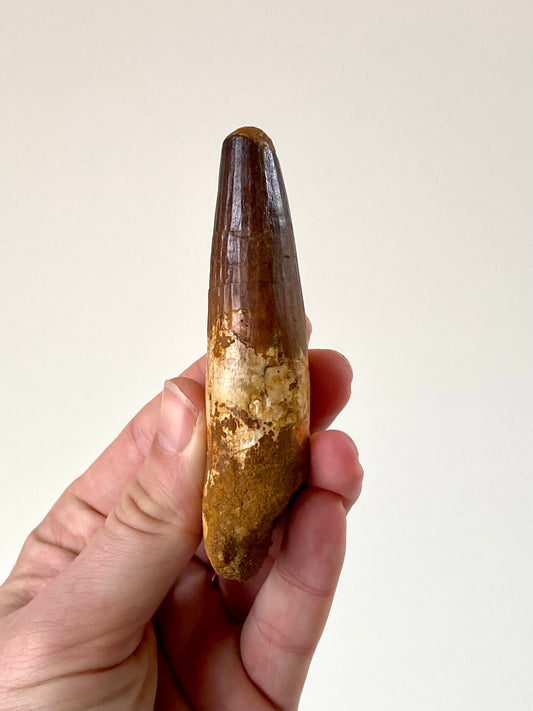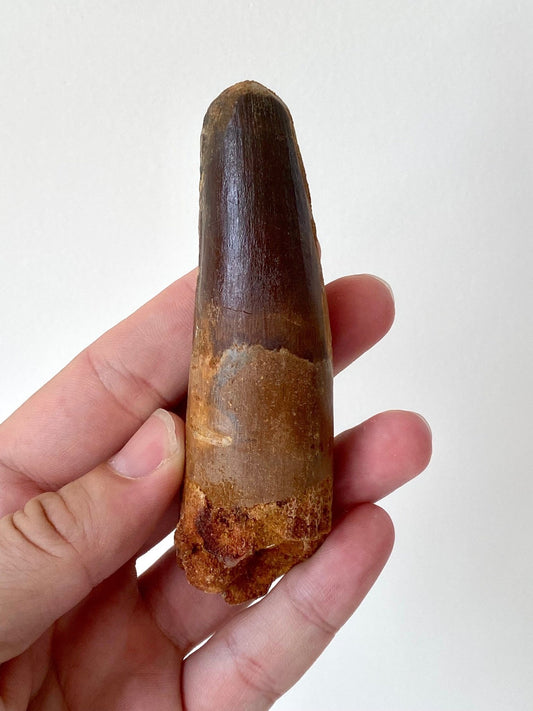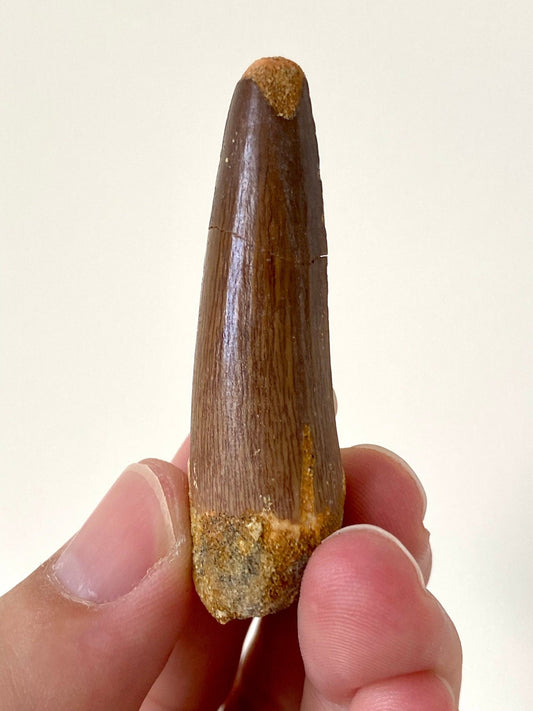Collection: Spinosaurus fossils for sale
All Spinosaurus fossils for sale. A genus of large theropod dinosaur that lived during the Cretaceous period, around 112 to 93 million years ago. It was a massive predator with a distinctive sail-like structure on its back. Spinosaurus is considered one of the largest theropods. Fossil discoveries in North Africa have provided insights into its aquatic adaptations, suggesting it spent significant time in water.
Continue reading below.
-
3.06" Spinosaurus fossil tooth
Regular price €70,00 EURRegular priceUnit price / per -
3.55" Spinosaurus fossil dinosaur tooth
Regular price €160,00 EURRegular priceUnit price / per -
3.85" Spinosaurus fossil dinosaur tooth
Regular price €120,00 EURRegular priceUnit price / per -
4.01" Spinosaurus fossil dinosaur tooth
Regular price €295,00 EURRegular priceUnit price / per -
2.82" Spinosaurus fossil dinosaur tooth
Regular price €70,00 EURRegular priceUnit price / per -
2.94" Spinosaurus fossil dinosaur tooth
Regular price €75,00 EURRegular priceUnit price / per -
4" (10,4 cm) Big Spinosaurus fossil tooth
Regular price €170,00 EURRegular priceUnit price / per -
3.8" (9,6cm) Large Spinosaurus fossil tooth
Regular price €195,00 EURRegular priceUnit price / per -
3" (7,7 cm) Large Spinosaurus fossil tooth
Regular price €85,00 EURRegular priceUnit price / per -
4.3" (11cm) Big Spinosaurus fossil tooth
Regular price €255,00 EURRegular priceUnit price / per -
2.48" (6.3 cm) Spinosaurus fossil tooth
Regular price €69,95 EURRegular priceUnit price / per -
1.33" (3.4 cm) Spinosaurus fossil tooth
Regular price €9,95 EURRegular priceUnit price / per€10,95 EURSale price €9,95 EURSale -
3.54" (9 cm) Big Spinosaurus fossil tooth
Regular price €145,00 EURRegular priceUnit price / per -
2.91" (7.4 cm) Large Spinosaurus fossil tooth
Regular price €95,00 EURRegular priceUnit price / per -
Spinosaurus fossil tooth (5.8cm)
Regular price €55,00 EURRegular priceUnit price / per -
Large Spinosaurus fossil tooth, (9.5cm)
Regular price €145,00 EURRegular priceUnit price / per
About Spinosaur
Spinosaurus, meaning "spine lizard," is a genus of theropod dinosaur that inhabited the ancient landscapes of what is now North Africa during the Late Cretaceous period, approximately 112 to 93 million years ago. This iconic dinosaur is known for its distinctive sail-like structure on its back, elongated snout, and potentially semi-aquatic lifestyle, making it one of the most intriguing and enigmatic creatures to have ever roamed the Earth.
Physical Characteristics
Spinosaurus was a truly imposing creature, estimated to have reached lengths of up to 49 to 59 feet (15 to 18 meters) and weighing several tons, making it one of the largest known carnivorous dinosaurs. Its most distinctive feature is the sail-like structure that ran along its back, formed by elongated neural spines that could reach heights of up to 5.9 feet (1.8 meters). These spines were likely covered in skin and may have been used for display, thermoregulation, or even swimming. Spinosaurus had a long and slender snout, conical teeth, powerful forelimbs with large clawed hands, and strong hind limbs adapted for terrestrial locomotion.
Habitat and Distribution
Spinosaurus inhabited the lush and swampy environments of North Africa during the Late Cretaceous period, including what is now Egypt, Morocco, and Algeria. These regions were characterized by extensive river systems, lakes, and mangrove forests, providing ample food and shelter for Spinosaurus and its prey. Fossil discoveries suggest that Spinosaurus may have been adapted to a semi-aquatic lifestyle, capable of swimming and hunting both on land and in water.
Feeding and Behavior
As a carnivorous dinosaur, Spinosaurus likely preyed upon a variety of animals, including fish, small to medium-sized dinosaurs, and other aquatic reptiles. Its elongated snout and conical teeth indicate adaptations for catching slippery prey, while its powerful forelimbs and large clawed hands may have been used to grasp and manipulate prey items. Recent studies suggest that Spinosaurus may have spent a significant portion of its time in water, using its sail-like structure for buoyancy and propulsion, similar to modern-day crocodiles.
Evolutionary Significance
Spinosaurus belongs to the family Spinosauridae, a group of large theropod dinosaurs characterized by their elongated snouts, conical teeth, and semi-aquatic adaptations. Spinosaurids represent a unique branch in the evolutionary tree of theropod dinosaurs, distinct from more well-known groups such as the Tyrannosauridae and Dromaeosauridae. The discovery of Spinosaurus has provided valuable insights into the diversity of dinosaurian adaptations and lifestyles during the Late Cretaceous period.
Cultural Impact and Discovery
Spinosaurus has captured the imagination of scientists and the public alike since its discovery in the early 20th century. The iconic depiction of Spinosaurus battling a Tyrannosaurus rex in the movie "Jurassic Park III" further cemented its status as a legendary dinosaur. Recent fossil discoveries, including a remarkably complete skeleton recovered in Morocco, have shed new light on the anatomy and behavior of Spinosaurus, fueling ongoing scientific research and exploration into this fascinating creature.
Spinosaurus stands as a testament to the incredible diversity and adaptability of life during the Late Cretaceous period. Through its unique anatomy, potential semi-aquatic lifestyle, and cultural significance, Spinosaurus continues to captivate the imagination of scientists and enthusiasts around the world, inspiring further exploration and discovery into the mysteries of our planet's ancient past.
Spinosaurus fossils for sale
































